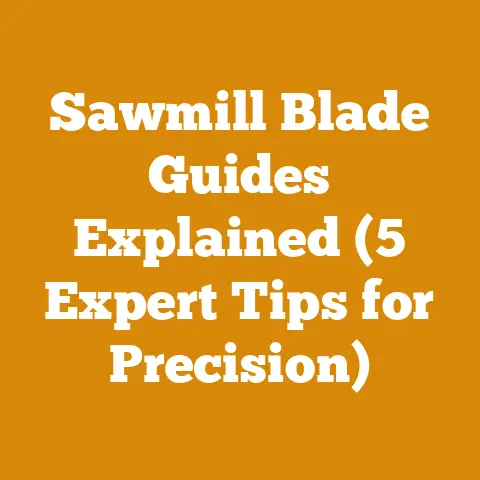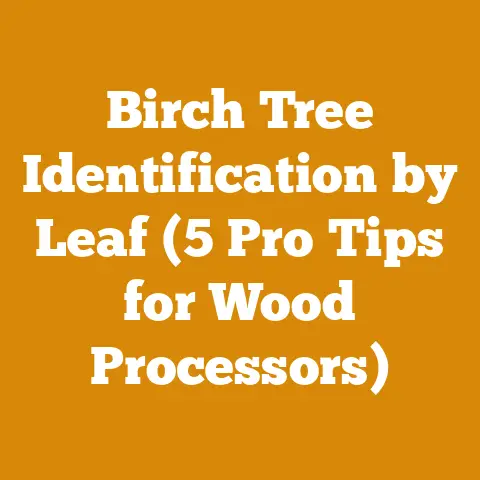Shrub Stump Killer Methods (5 Pro Chainsaw Tips Revealed)
Alright, folks, gather ’round! Ever feel like your yard is staging a shrub rebellion? Those stubborn stumps just won’t quit, huh? Well, I’ve wrestled with enough woody insurgents to declare myself a seasoned veteran in the war against unwanted shrubbery. Today, I’m spilling the beans (or should I say, sap?) on how to send those suckers packing using some good ol’ chainsaw know-how and a few tricks I’ve picked up over the years. Let’s turn those shrub stumps into… well, nothing! Let’s dive into my guide: “Shrub Stump Killer Methods (5 Pro Chainsaw Tips Revealed).”
Shrub Stump Killer Methods (5 Pro Chainsaw Tips Revealed)
I’ve faced my fair share of landscaping challenges, and believe me, shrub stumps are right up there with the worst of them. They’re unsightly, they attract pests, and they can be a real tripping hazard. Over the years, I’ve developed a few reliable methods, combining chainsaw techniques with effective stump-killing strategies. Let’s get started!
1. Assessing the Enemy: Understanding the Shrub Stump
Before you even think about revving up your chainsaw, take a good, hard look at what you’re dealing with. Is it a tiny twig of a stump, or a behemoth that looks like it’s been there since the dinosaurs roamed? The size and type of shrub stump will dictate the tools and methods you’ll need.
- Size Matters: A small stump might be easily ground down or dug out after treatment. A larger stump will require more aggressive techniques.
- Shrub Species: Some shrubs are more resilient than others. Knowing the species can help you choose the right herbicide. For example, I’ve found that privet and buckthorn are particularly stubborn and require repeated treatments.
- Root System: Consider how extensive the root system might be. Some shrubs send out runners, creating new shoots even after the main stump is gone.
My Personal Experience: I once underestimated a seemingly small lilac stump. After cutting it down, I thought a simple herbicide application would do the trick. A few weeks later, I had a whole army of new lilac shoots popping up all over my yard. Lesson learned: always research the shrub species!
2. Chainsaw Safety: Gear Up for Battle!
Alright, before we get to the fun part (aka, making sawdust), let’s talk safety. Chainsaws are powerful tools, and they demand respect. I’ve seen too many close calls to take this lightly.
- Personal Protective Equipment (PPE): This is non-negotiable.
- Eye Protection: Safety glasses or a face shield are a must. Flying wood chips are no joke.
- Hearing Protection: Chainsaws are loud. Earplugs or earmuffs will save your hearing.
- Gloves: Protect your hands and improve your grip.
- Chaps: Chainsaw chaps are designed to stop the chain in case of a kickback. Trust me, you want these.
- Boots: Sturdy, steel-toed boots will protect your feet from falling debris and accidental chainsaw contact.
- Chainsaw Inspection: Before each use, inspect your chainsaw:
- Chain Tension: Make sure the chain is properly tensioned. Too loose, and it can derail. Too tight, and it can bind.
- Chain Sharpness: A sharp chain is a safe chain. A dull chain requires more force and increases the risk of kickback.
- Bar Lubrication: Ensure the bar oil reservoir is full. Proper lubrication prevents overheating and extends the life of the bar and chain.
- Safety Features: Test the chain brake to make sure it’s working properly.
Pro Tip: I always keep a first-aid kit handy when working with a chainsaw. It’s better to be prepared for minor cuts and scrapes.
3. Chainsaw Method 1: The “Hollow Out” Technique
This method is great for larger stumps. The idea is to create a reservoir for the stump killer to penetrate deeply into the wood.
- Step 1: Cut the Stump Low: Use your chainsaw to cut the stump as close to the ground as possible. This makes it less visible and easier to cover later.
- Step 2: Hollow Out the Center: Carefully use the tip of your chainsaw to hollow out the center of the stump. Aim for a bowl-shaped depression about 4-6 inches deep. Be cautious not to let the tip of the chainsaw kick back.
- Step 3: Drill Holes: Drill several holes (1/2 inch diameter) around the perimeter of the stump, angling them downwards towards the center. These holes will help the herbicide reach the roots.
- Step 4: Apply Stump Killer: Pour a concentrated stump killer (I recommend glyphosate or triclopyr-based products) into the hollowed-out center and the drilled holes. Follow the manufacturer’s instructions carefully.
- Step 5: Cover the Stump: Cover the stump with a tarp or plastic sheet to protect it from rain and prevent the herbicide from being diluted. Secure the tarp with rocks or stakes.
My Personal Story: I once used this method on a massive rhododendron stump. It was so big that I had to refill the hollowed-out area with stump killer several times over a few weeks. Persistence pays off!
4. Chainsaw Method 2: The “Kerf Cut” Technique
This method is ideal for smaller to medium-sized stumps. It involves making a series of cuts into the stump to increase the surface area for herbicide absorption.
- Step 1: Cut the Stump Low: As with the previous method, start by cutting the stump as close to the ground as possible.
- Step 2: Make Kerf Cuts: Use your chainsaw to make a series of parallel cuts (kerfs) across the top of the stump. The cuts should be about 1-2 inches deep and spaced about 1-2 inches apart.
- Step 3: Apply Stump Killer: Apply the stump killer liberally to the cuts, ensuring it soaks into the wood.
- Step 4: Cover the Stump: Cover the stump with a tarp or plastic sheet to protect it from rain.
Pro Tip: For particularly stubborn stumps, I sometimes alternate between the hollow-out and kerf cut techniques. This provides maximum herbicide penetration.
5. Stump Killer Selection: Choosing Your Weapon
Not all stump killers are created equal. Choosing the right one can make all the difference between success and frustration.
- Glyphosate: This is a systemic herbicide that is absorbed by the plant and transported to the roots, killing the entire plant. It’s effective on a wide range of shrub species.
- Triclopyr: Another systemic herbicide that is particularly effective on woody plants. It’s a good choice for shrubs that are resistant to glyphosate.
- Epsom Salts: Some folks swear by Epsom salts as a natural stump killer. While it might not be as potent as chemical herbicides, it can help to dry out the stump and make it easier to decompose. To use Epsom salts, drill holes in the stump and fill them with the salts. Then, wet the salts with water. Repeat this process every few weeks.
- Copper Sulfate: Copper sulfate is a chemical compound that can be used to kill stumps. To use it, drill holes in the stump and fill them with copper sulfate crystals. Then, wet the crystals with water. Be careful when handling copper sulfate, as it can be harmful to the environment.
Important Considerations:
- Read the Label: Always read and follow the manufacturer’s instructions on the herbicide label.
- Environmental Impact: Be mindful of the environmental impact of the herbicide you choose. Glyphosate, in particular, has been the subject of much debate.
- Safety: Wear appropriate protective gear when handling herbicides.
My Recommendation: I generally prefer triclopyr-based products for stubborn shrub stumps. I’ve found them to be more effective than glyphosate in many cases.
6. Patience is a Virtue: The Waiting Game
Killing a shrub stump isn’t an overnight process. It takes time for the herbicide to work its way through the plant’s system and kill the roots.
- Monitor the Stump: Check the stump regularly for signs of new growth. If you see any new shoots emerging, reapply the herbicide.
- Repeat Applications: You may need to apply the stump killer several times over a period of weeks or months.
- Decomposition: Over time, the stump will begin to decompose. This process can take several months to a year, depending on the size of the stump and the type of wood.
My Experience: I once treated a large oak stump with herbicide, and it took nearly a year for it to completely decompose. Be patient, and don’t give up!
7. Chainsaw Method 3: The “Grid Pattern”
This technique is useful for larger, flatter stumps where you want to ensure even distribution of the herbicide.
- Step 1: Cut the Stump Level: Begin by cutting the stump as level as possible to create a stable surface.
- Step 2: Create a Grid: Use your chainsaw to cut a grid pattern into the top of the stump. The lines should be about 2-3 inches apart, creating a checkerboard effect. Make the cuts about 1-2 inches deep.
- Step 3: Apply Stump Killer: Apply the stump killer generously to the grid pattern, ensuring that it fills all the cuts.
- Step 4: Cover the Stump: Cover the stump with a tarp or plastic sheet to protect it from rain.
Why This Works: The grid pattern maximizes the surface area exposed to the herbicide, allowing for better absorption and distribution throughout the stump.
8. Chainsaw Method 4: The “Side-Drilling” Technique
This method is effective when you want to target specific areas of the stump, such as where new shoots are emerging.
- Step 1: Identify Problem Areas: Look for areas on the stump where new shoots are sprouting.
- Step 2: Drill Holes at an Angle: Use a drill to create holes at a downward angle into the stump, near the base of the new shoots. The holes should be about 1/2 inch in diameter.
- Step 3: Apply Stump Killer: Inject the stump killer directly into the drilled holes.
- Step 4: Seal the Holes: Seal the holes with caulk or wood filler to prevent the herbicide from leaking out.
Pro Tip: This method is particularly useful for targeting specific problem areas without saturating the entire stump with herbicide.
9. Chainsaw Method 5: The “Complete Removal” Option
Sometimes, the best way to deal with a shrub stump is to remove it entirely. This is a more labor-intensive option, but it eliminates the need for herbicides and leaves you with a clean slate.
- Step 1: Expose the Roots: Use a shovel to dig around the stump and expose the main roots.
- Step 2: Cut the Roots: Use your chainsaw to cut through the roots. Be careful not to cut into any underground utilities.
- Step 3: Remove the Stump: Once the roots are cut, you should be able to rock the stump back and forth and eventually remove it from the ground. You may need to use a pry bar or a winch to help you.
- Step 4: Fill the Hole: Fill the hole with topsoil and plant grass or other ground cover.
My Experience: I once removed a large holly stump using this method. It was hard work, but it was satisfying to get rid of it completely.
10. Alternative Stump Removal Methods
While chainsaws and herbicides are my go-to tools, there are other options for dealing with shrub stumps.
- Stump Grinder: A stump grinder is a machine that grinds the stump down into small chips. This is a quick and effective way to remove a stump, but it can be expensive to rent a stump grinder.
- Digging: For smaller stumps, you can simply dig them out with a shovel and a pickaxe. This is a labor-intensive option, but it’s free and doesn’t involve the use of chemicals.
- Burning: In some areas, it’s legal to burn stumps. This is a quick and effective way to get rid of a stump, but it’s important to check local regulations before burning.
- Natural Decomposition: You can speed up the natural decomposition process by keeping the stump moist and adding nitrogen-rich materials, such as compost or manure.
Pro Tip: If you’re hiring a professional to remove a stump, be sure to get several quotes and check their references.
11. Chainsaw Maintenance: Keeping Your Saw Sharp
A well-maintained chainsaw is a safe and efficient chainsaw. Regular maintenance will extend the life of your saw and prevent costly repairs.
- Chain Sharpening: A dull chain is a dangerous chain. Sharpen your chain regularly using a chainsaw file or a chain grinder.
- Bar Maintenance: Clean the bar groove regularly to remove debris. Check the bar for wear and tear and replace it when necessary.
- Air Filter: Clean the air filter regularly to ensure proper airflow to the engine.
- Spark Plug: Replace the spark plug periodically to ensure reliable starting.
- Fuel: Use fresh, high-quality fuel and oil.
- Storage: Store your chainsaw in a dry place, away from moisture and extreme temperatures.
My Routine: I sharpen my chainsaw chain after every few uses, and I perform a thorough cleaning and inspection at the end of each season.
12. Safety First: Avoiding Common Chainsaw Mistakes
Chainsaws are powerful tools, and it’s important to use them safely. Here are some common mistakes to avoid:
- Cutting Above Shoulder Height: This is dangerous because it’s difficult to control the saw.
- Cutting with the Tip of the Bar: This can cause kickback, which is a sudden and violent reaction that can throw the saw back at you.
- Cutting in Unstable Positions: Make sure you have a firm footing before cutting.
- Working Alone: It’s always a good idea to have someone nearby when working with a chainsaw.
- Ignoring Safety Warnings: Read and follow all safety warnings in the chainsaw’s owner’s manual.
My Rule: If I’m ever unsure about a cutting situation, I stop and reassess. It’s better to be safe than sorry.
13. Choosing the Right Chainsaw for the Job
The type of chainsaw you use will depend on the size and type of stumps you’re dealing with.
- Small Chainsaws (12-14 inch bar): These are good for small stumps and light-duty work.
- Medium Chainsaws (16-18 inch bar): These are versatile saws that can handle a wide range of tasks.
- Large Chainsaws (20+ inch bar): These are for large stumps and heavy-duty work.
My Preference: I prefer a medium-sized chainsaw with a 16-inch bar for most stump removal tasks. It’s powerful enough to handle most stumps, but it’s still lightweight and easy to maneuver.
14. Understanding Wood Decay: How Stumps Decompose
Understanding the natural process of wood decay can help you choose the best stump removal method.
- Fungi: Fungi are the primary agents of wood decay. They break down the cellulose and lignin in the wood, causing it to rot.
- Moisture: Moisture is essential for fungal growth. Keeping the stump moist will speed up the decomposition process.
- Nitrogen: Nitrogen is another important nutrient for fungi. Adding nitrogen-rich materials, such as compost or manure, will accelerate decomposition.
- Insects: Insects, such as termites and carpenter ants, can also contribute to wood decay.
Pro Tip: You can encourage wood decay by drilling holes in the stump and filling them with compost or manure.
15. Legal Considerations: Checking Local Regulations
Before you start removing shrub stumps, it’s important to check local regulations. Some areas may have restrictions on the use of herbicides or burning.
- Herbicide Restrictions: Some areas may restrict the use of certain herbicides, such as glyphosate.
- Burning Regulations: Some areas may prohibit burning altogether, or they may require a permit.
- Underground Utilities: Before digging, call your local utility company to locate any underground utilities.
My Advice: Always err on the side of caution and check with your local authorities before starting any stump removal project.
16. The Environmental Impact of Stump Removal
It’s important to consider the environmental impact of your stump removal methods.
- Herbicide Use: Herbicides can have negative impacts on the environment, including contaminating soil and water.
- Soil Erosion: Removing stumps can disturb the soil and lead to erosion.
- Habitat Loss: Removing stumps can destroy habitat for wildlife.
My Approach: I try to use the most environmentally friendly stump removal methods possible, such as digging or natural decomposition.
17. Dealing with Sprouting Stumps
Even after treating a stump with herbicide, it may still sprout new shoots. Here’s how to deal with sprouting stumps:
- Reapply Herbicide: Apply herbicide directly to the new shoots.
- Cut the Shoots: Cut the shoots off at the base.
- Dig Up the Roots: Dig up the roots and remove them from the ground.
Pro Tip: Be persistent! It may take several attempts to kill a sprouting stump.
18. Preventing Future Shrub Problems
Once you’ve removed the shrub stumps, take steps to prevent future problems.
- Choose the Right Shrubs: Choose shrubs that are well-suited to your climate and soil conditions.
- Proper Planting: Plant shrubs properly, giving them enough space to grow.
- Regular Pruning: Prune shrubs regularly to keep them healthy and prevent them from becoming overgrown.
- Monitor for Pests and Diseases: Monitor shrubs regularly for pests and diseases and take action to control them.
My Philosophy: Prevention is always better than cure.
19. Chainsaw Safety Refresher: A Final Reminder
Before you head out to tackle those shrub stumps, let’s go over chainsaw safety one last time.
- Wear PPE: Eye protection, hearing protection, gloves, chaps, and steel-toed boots are essential.
- Inspect Your Chainsaw: Check the chain tension, chain sharpness, bar lubrication, and safety features.
- Use Proper Cutting Techniques: Avoid cutting above shoulder height, cutting with the tip of the bar, and cutting in unstable positions.
- Work Safely: Work with a partner, avoid distractions, and take breaks when needed.
My Motto: Safety first, always!






